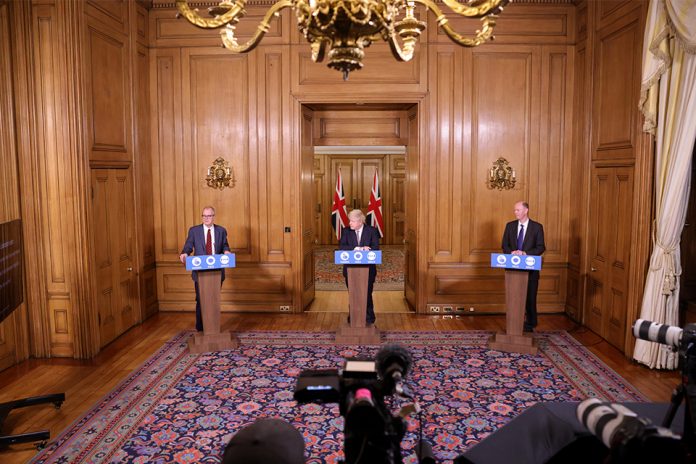Prime Minister’s statement on coronavirus (COVID-19): 26 November 2020
We now have reason to hope that by Spring, community testing and vaccines will combine to end this era of restrictions.
But to get there we must first navigate a hard winter when the burden on our NHS is heaviest and the cold weather favours the virus.
The data already suggests national measures in England have slowed – and in some places reversed – the growth of new cases.
As more data comes in, we hope and expect to see those trends continue.
Together we have prevented our NHS from being overwhelmed,
but those dangers have not gone away.
If we ease off now, we risk losing control of this virus all over again,
casting aside our hard won gains,
and forcing us back into a New Year national lockdown with all the damage that would mean.
The tough measures in our Winter Plan are the best way to avoid this outcome.
All our friends around the world are grappling with the same question of how to keep people safe without retreating into a winter of hibernation.
In Italy there is a nightly curfew,
in Germany, hospitality will remain closed until 20th December,
and in France, until 20 January.
Across the whole of the UK, measures remain in place to control the virus.
Under our Winter Plan, England will return to a tiered system of local restrictions.
Our decisions on which area enters which tier are based on public health advice according to five indicators:
cases across all ages,
especially the over 60s,
the rate by which cases are rising or falling
the percentage of those tested in a local population who have Covid
and the pressure on the NHS.
We are publishing data packs setting out the reasons behind decisions in each area.
To find out how this affects you, log on to gov.uk where all the information is available.
I’m sorry to confirm that, from Wednesday, most of England will be in the top two tiers with the toughest measures.
I know this will bring a great deal of heartache and frustration, especially for our vital hospitality sector,
our pubs, our restaurants, our hotels, in so many ways the soul of our communities –
which continue to bear a disproportionate share of the burden.
I really wish it were otherwise, but if we are to keep schools open – as we must – then our options in bearing down on the disease are necessarily limited.
What we will do is continue taking every possible step to protect jobs and livelihoods across the UK.
These tougher tiers strike a balance – they are sufficient to continue driving the virus downwards but it’s important to recognise they are less intrusive than the current national measures.
In all tiers, shops, gyms and the leisure sector, hairdressers, other forms of personal care, places of worship will reopen.
You will no longer be instructed to stay at home, though you should continue to work from home if you can.
The rule of 6 will once again apply in public outdoor spaces and organised outdoor sport can begin again.
But there is no doubt that the restrictions in all tiers are tough – and I am sorry about that.
While the data is beginning to improve, the virus is still prevalent, and the faster we drive it down the faster we can lift restrictions.
And that is exactly what these new tiers are designed to achieve.
While the previous tiers slowed the spread of the virus,
they were never quite enough to cut the R below 1 and keep it there,
so areas did not escape whatever level they were placed in.
Our new approach is designed to reduce R below 1,
opening a path for areas to move down the scale, as soon as the situation improves.
And crucially, we now have the means to accelerate that moment of escape with rapid community testing,
allowing anyone carrying the disease – including those without symptoms – to isolate
thereby reducing the R.
And the truth is that at least one in three people with Covid have no symptoms at all and may be spreading the disease without even knowing that they’ve got it.
The only way to identify them and protect everyone is through mass testing.
Liverpool shows what can be achieved.
In Liverpool, in the space of two and a half weeks, over 240,000 tests have been conducted
and together with the effect of national restrictions,
this has helped to reduce the number of cases in Liverpool City Region by more than two thirds.
So having previously been in tier 3, Liverpool City Region and Warrington will now be in tier 2.
This is a success story which we want other parts of the country to replicate
so we will work with local government, public health leaders and our fantastic Armed Forces,
to offer community testing to tier 3 areas as quickly as possible,
opening the way for them to follow Liverpool’s example.
Testing on this scale is untried, but in due course, if it works, where people test negative, it may also be possible for families and communities to be released from certain restrictions
even if their home area stays in tier 3.
The allocation of tiers will be reviewed every fourteen days, starting on 16 December.
So your tier is not your destiny.
Every area has the means of escape.
And I have no doubt that together we can get through this Winter,
suppress the virus until vaccines come to our aid,
and then reclaim our lives and all the things that we love.







